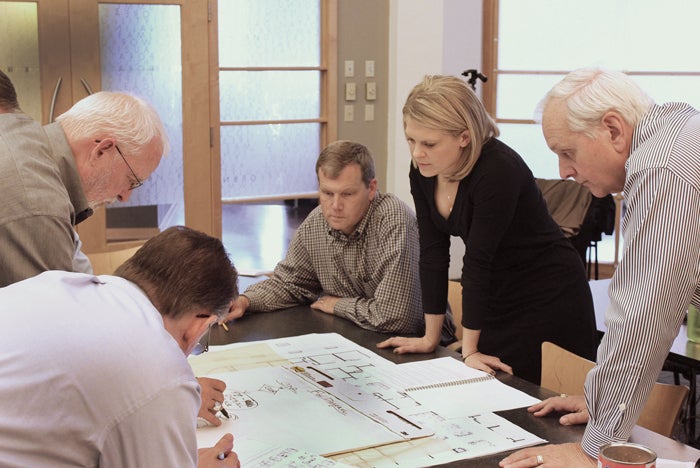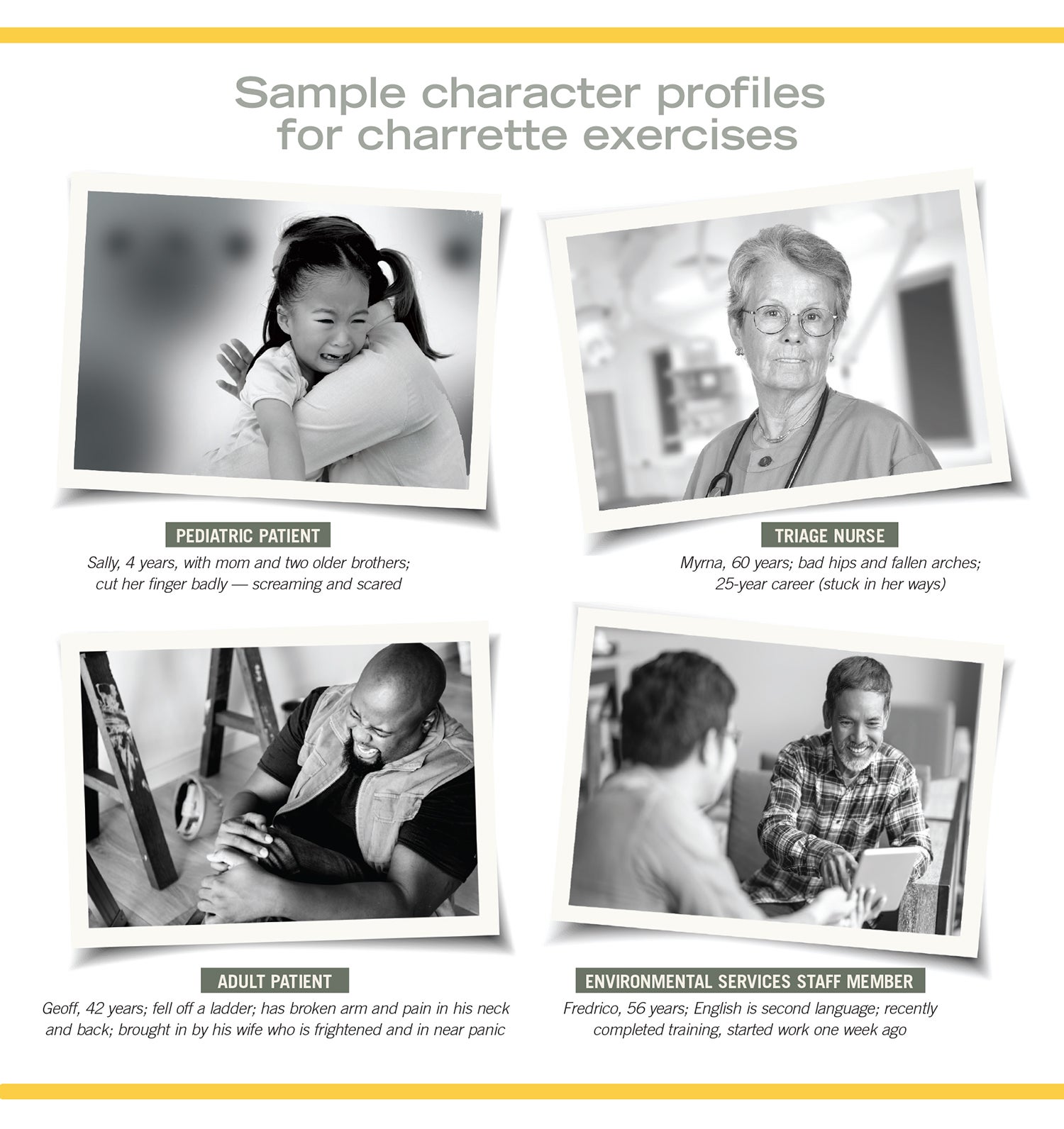Making design research matter

A multidisciplinary charrette team develops an alternative solution scenario based on post-occupancy evaluation findings.
Image courtesy of the College of Design, School of Interiors, University of Kentucky
While evidence-based design (EBD) is increasingly utilized to guide decision-making, practitioners still may be unclear about interpreting evidence and within what context it should be applied. This suggests that more manageable criteria are needed to determine how research findings can be fed forward in a usable and accessible manner.
The full cycle of a post-occupancy evaluation (POE) process should lead to the application of knowledge gained, thus strengthening the design process and informing future decision-making. However, the final, or application, phase is a critical but often neglected stage in the POE process.
Moving information forward
Too often, outcomes of a POE end with the step of reporting the findings rather than demonstrating a practical application. How this knowledge feeds forward is often unclear.
One of the primary challenges in presenting the results of POEs is not only to disseminate the information back to the owner, but also to transfer the information to the world of practice as well as an academic venue. However, most organizations have no established system for knowing how to process, direct and act on the information they receive from a POE, according to a 2002 paper titled “Post-occupancy evaluation: A multifaceted tool for building improvement” by Jacqueline Vischer in the Federal Facilities Council’s Technical Report No. 145, “Learning from our buildings: A state-of-the-practice summary of post-occupancy evaluation.”
An overt statement of which steps could be taken to address the negative aspects should be created to render the POE more viable. Thus, the design charrette can serve as an interactive method to assist design practitioners in both understanding and applying research findings.
Because the significance of the data collected in POE research is not apparent without the application of research findings, the use of a design charrette presents an opportunity to engage with research to inform future designs while also developing familiarity with the POE framework and methodologies. Further, because the user is at the core of EBD and POE studies, strategies for translating POE findings into design practice should aim to develop a deeper understanding of the problems and realities of the people for whom designs are being created.
Design charrette constructs
Resources
In preparation for the charrette, the research team should perform a literature search to identify existing evidence relative to the subject under consideration and subsequently prepare a pre-charrette report of the literature as related to design issues revealed through the POE. The report should include a questionnaire for charrette participants on their role in the project, experience in the field, knowledge of design strategies and knowledge of EBD. Each charrette team member should receive this report at least one week prior to the charrette to become sufficiently acquainted with the issues.
On the day of the charrette, the team should convene in a room large enough to have pin-up accommodations and flexible furnishings. Recommended materials include computers, large-format monitor screens, flip charts, markers, floor plans and pin-up devices (tape or pins). The researchers will lead participants through a series of charrette exercises. When considering the use of the charrette as a process for linking POE findings to the design application, it is recommended that the POE charrette should use an all-inclusive, collaborative process, easily interpreted evidence, active participant engagement with the evidence, and feasible outcomes grounded in research.
Looking specifically at each of these charrette constructs, the importance of including all key players cannot be underestimated. Members of the design team, researchers, health care providers and administrators, and other end users such as patients and visitors should be included. The engagement of interdisciplinary participants provides unique expertise, a greater sensitivity to the needs of potential users and brings a shared vision to the design process. An all-inclusive, collaboration offers participants a voice in the design process, resulting in greater diversification in design ideation and increased confidence in design decisions.

Secondly, the POE charrette should provide multimodal opportunities for working with the evidence to ensure accurate interpretation. Practicing designers are often unsure of how to effectively translate academic language into usable results for application, according to a 2007 article titled “Bridging design & research” by D. Kirk Hamilton in the Health Environments Research & Design (HERD) Journal. Instead, a visual or diagrammatic representation of evidence is recommended because designers think, analyze and synthesize evidence visually. However, the importance of written research should not be dismissed as it provides an appropriate context to understanding the breadth and depth of research findings.
As such, a variety of formats offers a more inclusive understanding of the evidence, ensuring that research interpretation aligns with the learning styles of all participants. By presenting outcomes in a variety of formats, it is more likely that people will connect with the research and use it to impact future designs.
The more actively the design team is engaged in the POE process, the greater the likelihood that research outcomes will be integrated into future designs, benefits will be seen and future POEs will be conducted. This reinforces the cyclical nature of both the EBD and POE processes. The charrette process can offer a positive mark of completion to the POE and helps participants gain sensitivity to the importance of evidence-based decision-making.
To ensure the greatest level of active participation in the POE charrette, participants should be involved in various types of engagement with ample time to support each. These might include a focused engagement with the pre-charrette report outlining objectives and findings, participation in a variety of charrette exercises and allocating sufficient time to thoughtfully complete, reflect and share outcomes from the experience.
Implementing a charrette that is included as part of a full- or even multiday experience will help to ensure that the design team can thoughtfully reflect on and apply presented evidence. In addition, working in teams consisting of small cohorts of participants can help to ensure that everyone can be involved and multiple ideas are generated.
Lastly, to ensure an optimal experience, the charrette must produce feasible outcomes grounded in research. Ideally, POE outcomes should be used both to improve the fit of the existing space and to be fed back into the design research and programming of the next building. While the POE process ostensibly evaluates the project against the assumptions and expectations outlined in the design phase, often unexpected findings occur that are truths to be carried forward to future projects. Ultimately, it is the goal of both a POE and a design charrette to produce transformative change.
Charrette exercises
It is recommended that charrette exercises be human-centered and include engaging exercises such as the development of character profiles, activity analysis, flow diagrams, scenario sketching and an annotated floor plan with alternative design responses to the issue under consideration.
The goal of character profiles helps to bring the users of the space to life and build empathy for the values and abilities of various user groups. The charrette team can role-play these profiles to simulate and empathize with potential end users. They should consider a variety of ages, abilities and ethnicities.
In an activity analysis, participants can list a range of activities that occur during various health care delivery processes to ensure consideration of the physical and psychological needs of the various user groups, and to determine how the physical environment can respond.
The team should create a detailed list of all tasks, actions, equipment needed and users involved with the outlined activities. Flow diagrams can be used to map activities for all phases of the care episode or processes for each character and to assess operational processes that ensure that the design proposal will support an efficient workflow and positive user experience.
Designers should be sure to consider where key decision points may occur and the relevant actions that ensue. Scenario sketches can be used to challenge participants to think outside the physical limitations of the extant space and develop scenarios that represent big ideas with no limitations. These should consider socio-cultural and technological trends and their implications for operational changes and user experiences.
Lastly, the charrette should ultimately utilize these exercises to inform and develop a floor plan or new design that effectively communicates the application of research with alternative solutions. Enough time should be allocated to explore several alternatives. Charrette subteams can then pick their best alternative and present it to the entire charrette participant group for discussion and critique. After each iteration is presented, an overall evaluation comparing the attributes of each can follow, with the goal of making a recommended solution. It is possible that the recommendation may include more than one solution.
Once a recommendation is achieved, the charrette is concluded. However, the recommendation then will need to be prepared for presentation. This step will be placed in the hands of the architects and interior designers to prepare annotated plans, diagrams and explanations suitable for publication. Additionally, an estimate of costs and a timeline to make the suggested changes to the physical space should be developed for the owner’s elucidation.
Bridging the gap
The Center for Health Design identifies the measurement of post-occupancy performance results as an important step in the EBD process in its 2010 study guide, “An introduction to evidence-based design: Exploring healthcare and design (second edition).” The increased application of EBD in practice is an important advancement for the profession because it takes design out of the intuitive and provides a foundation for decision-making.
Taking the POE process full cycle is a critical component in bridging the gap between research and its application to design. The use of a collaborative design charrette between researchers and practitioners can offer a stimulating challenge for researchers to present and share their findings in a meaningful and memorable manner and for practitioners to think critically about this information and its implications for the built environment.
Ultimately, the implemented charrette exercises should engage an all-inclusive, participatory design process offering active participant engagement with the evidence. It is also important to include a variety of potential users, including health care providers, administrators and others who may utilize the environment as key participants in the charrette process. Doing so bridges the gap between designers and users, and further exposes them to the importance of the process of POEs.
As noted by Caren S. Martin in a 2009 article titled “The challenge of integrating evidence-based design” in the HERD Journal, “Both the integration of research findings into practice and the documentation of practice-based outcomes are essential to increase a body of professional knowledge.”
The challenge for the health care design field is now twofold: Designers must be able to translate research findings into tangible concepts that manifest as constructive applications and to hypothesize advancements in concepts that will be tested in subsequent analysis.
James W. Harrell, FAIA, FACHA, EDAC, ACHE, is senior architect for health care planning, Elevar Design Group, Cincinnati, and Lindsey Fay, EDAC, is assistant professor at the College of Design in the School of Interiors, University of Kentucky, Lexington. They can be reached at jharrell@elevar.com and Lindsey.fay@uky.edu.
About this article: This feature is one of a series of articles published by Health Facilities Management in partnership with the American College of Healthcare Architects.





